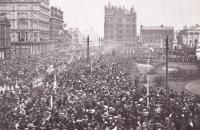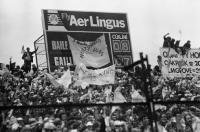The Ulster Covenant BBC1 Northern Ireland, 27 September 2012 Cogar: Cnóc 16 TG4, 23 September 2012
Published in 20th Century Social Perspectives, 20th-century / Contemporary History, Issue 6 (Nov/Dec 2012), Reviews, Volume 20, World War I
The scene outside Belfast City Hall on Ulster Day, 28 September 1912. (Ulster Museum)
The Ulster Covenant was written and presented by William Crawley and was broadcast the evening before the centenary of ‘Ulster Day’, 28 September 1912, the day on which 237,368 Protestant Ulstermen signed the titular declaration and pledged themselves to use ‘all means necessary to defeat the present conspiracy to set up a Home Rule parliament in Ireland’. If one were to choose the phrase that started the Irish Revolution, this would surely be it. As Eoin MacNeill put it, ‘the north began’. Unionist resistance to Home Rule—the covenant was ‘a conditional declaration of war’, according to Crawley—militarised Irish politics on the eve of the First World War. In terms of its actual impact on Irish life, the covenant was of immeasurably greater significance than the far-better-known 1916 Proclamation (a document that even took some of those occupying the GPO by surprise). Even aside from the men who signed the covenant in a hugely impressive piece of political theatre, 234,046 Protestant women signed an accompanying declaration of support. It was highly unlikely that any Catholic unionist would have signed it, as it was explicitly drawn from the Presbyterian tradition.
The covenant was inspired by the Scottish covenant of the seventeenth century; James Craig got the idea thanks to a chance encounter in a London club. A sense of historic community was important to the unionist case—when Edward Carson made his way to Belfast City Hall to sign the covenant he was apparently preceded by a Williamite battle flag—but the language of the seventeenth century was hardly appropriate to 1912. The forceful and lucid text of the covenant was composed by the MP Thomas Sinclair, an Ulster liberal who had broken with his party over the issue of Home Rule.
Crawley’s film was not just about the covenant: it also took a broad look at Ulster unionist resistance to Home Rule, which was often highly illegal and technically treasonous. The first of the unionist concerns set forth in the covenant relates to ‘the material well-being of Ulster’. The industrial prosperity of the Protestant north-east illustrated the virtues of membership of the Empire and proved to many in Protestant Ulster that British rule was working; so if it wasn’t broken, why fix it? While the prospect of being governed by the Catholic majority was most unwelcome on sectarian grounds, a region so dependent on industry was hardly going to like the idea of being governed by Catholic farmers as well (and, as Paul Bew mordantly pointed out, unionist fears of impoverishment and ‘Rome rule’ were hardly dispelled by the record of the southern state after 1922). But Home Rule was also seen as the thin end of the wedge; while modest in itself, it could have the potential to prompt an unstoppable momentum towards separatism. The formidable and impressive mobilisation of armed unionism (see Philip Orr’s article in this issue, pp 30–4) was intended to prevent this. The covenant pithily set out the unionist case; the existence of the UVF stated that they were deadly serious.
One of the hoary myths about the covenant was dispelled here—the claim that some of those who signed it did so in their own blood. Fred Crawford, who later masterminded the Larne gunrunning, claimed that he had: whether he did, or just used red ink, remains unclear, but he is the likeliest candidate to have done so. This was a sober, impressive and highly watchable piece of TV history, though perhaps more time could have been spent teasing out the reactions that the covenant provoked amongst nationalists, southern unionists and in Britain itself. The Irish Revolution was a tapestry woven from a number of interlocking elements, and the impending centenaries will need to reflect this.

The Hill’s alive!—‘Heffo’s Army’ cheer on their team on the way to beating Galway in the 1974 All-Ireland final. The Cogar documentary busted the myth that Hill 16 was built from the rubble left behind after the British army shelled Dublin during the Easter Rising. (Irish Photo Archive)
Speaking of the ‘decade of centenaries’, TG4 displayed an admirable cheek in broadcasting a short history of Hill 16 hours after the All-Ireland football final. The Hill is usually associated with Dublin fans, and its link to the capital is strengthened by the patriotic assumption that it was built from the rubble left behind after the British army shelled Dublin during the Easter Rising; the Dubs apparently had the dead generations on their side, if nobody else. The story is, however, a complete fabrication, as Hill 16 was created a year before the rising as an embankment for spectators, and was originally dubbed Hill 60, after a hill in Gallipoli on which members of the Royal Dublin Fusiliers suffered heavy casualties in 1915. The name stuck throughout the 1920s and 1930s until senior members of the GAA made clear their disgruntlement. It was seen as highly incongruous to have a section of Croke Park named after a battle involving the British army; after all, the Hogan stand was named after the Tipperary captain shot dead on the pitch by British forces on Bloody Sunday in 1920. So Hill 60 became Hill 16, and around the fiftieth anniversary of the rising the story of how it was built from the ruins of O’Connell Street began to circulate. This became sufficiently entrenched that when the stadium was eventually redeveloped, archaeologists were on hand to sift through the rubble of the old terrace, presumably in the expectation that they might find old bullets, or fragments of the GPO. They didn’t.
Having gotten that out of the way, the rest of the documentary focused upon the Hill in relation to Dublin fans. In doing so it unearthed some surprising cross-pollinations between the GAA and other sports. The rise of ‘Heffo’s Army’ in the 1970s, for example, brought with it the importation of chants from English soccer. The Dubs have long since abandoned ‘You’ll never walk alone’ for the somewhat less ecumenical ‘Hill 16 is Dublin only’, and while the Hill is an undeniably colourful place to be during a Dublin match, other fans stand on it too: surely there is another history of the Hill waiting to be told? HI
John Gibney is History Ireland news editor.
















